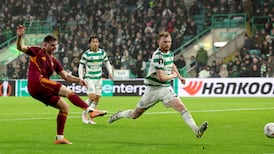"He might be a fan, he might be a nutter, but he's on my turf and I'm gonna chop the mother down." The words of Keith Richards, who famously raised his Fender Telecaster and used it as a club to repel a stage-invading fan as The Rolling Stones played Satisfaction at the Hampton Coliseum in 1981.
Keith’s reaction might have seemed a little extreme at the time. As might the slightly hysterical response of some observers to the spate (there have been three) of pitch-invading fans in British football over the weekend, with calls for deductions and stadium closures, fears of imminent player death and all the rest.
Yes, it’s here again. Welcome to football’s shame, episode 94. Arm our referees. Ban the thugs. Cage them. Electrocute them. Chop these mothers down. To those who lived through the 1980s, the reforms of the 1990s seemed to have killed that decade for good. And yet, 30 years on, the people are still revolting, football is an angry, fractured place, and this town is, once again, becoming like a ghost town.
New-wave disorder
Birmingham saw the most alarming incident of new-wave disorder. The assault on Jack Grealish during Birmingham City's home fixture against Aston Villa was a wretched moment in so many ways. Grealish was hit from behind by a man who had run from the touchline. As the man walked off sections of the home crowd applauded. Look closely and Grealish's assailant appears to be wearing clothes with the Z symbol of the Zulu hooligan firm, a remnant of the uglier parts of decades past.
This followed the arrest on Friday night of a man at Easter Road for leaping out of the stands and confronting a Rangers player. It preceded the arrest of a pitch invader at the Emirates Stadium on Sunday night. At which point cue the talk of decay and unrest, of rising feral tides, the difficulty, above all, of keeping any kind of perspective.
Why is this happening now? And how do we stop it? On the most basic level there is clearly a degree of mimesis at work. Which is another way of saying impressionable idiots copying each other. A small number of people have run on to the pitch because they’ve realised they can.
A minor point here, but it is perhaps worth noting the widespread use of recreational drugs at football. There are certain areas within certain grounds where the half-time toilets have an air of Freddie Mercury powder-party debauchery, just without the sense of glamour. Throw several thousand impressionable young men together, ramp up the ambient levels of rage; and yes, people are likely to start pushing the boundaries, busting in through the fourth wall, losing their sense of scale.
Zero tolerance
The obvious response is better management of the details. The fad for running on needs to be approached with zero tolerance and a big stick. Throw the book at them. Throw another book. Pick the first book up and throw it again. A 14-week prison sentence, as was handed out to the Birmingham fan yesterday, is a good start.
The better question is: why does the crowd need so much controlling? And who is in charge of fixing it?
Stewards deserve our sympathy here: it is a thankless, low-paid, undertrained job. The sight of unfit, visibly confused men in hi-vis jackets trying to deal with deranged spectators is a sign of misused resources. Stewarding as first-response security is something different to simply crowd control.
More aggressive, interventionist pitch protection can only be provided by people with the right training. It seems clear now this is not being done. Football in the top two divisions has the money to act, to beef up its security resources, and to be held to a higher standard if people do get on the pitch. So much for crowd control. As ever, the better question is: why does the crowd need so much controlling? And who is in charge of fixing it?
Football clubs will be punished for offences committed on their premises. But there is an element of cognitive dissonance in the repeated assertion that “football” itself, the propulsion of an inflated leather sphere through a netted rectangle, is responsible for the way people behave, for the way people are.
There is no separate entity called football. It is simply another part of the mixed and flowing populace, the one place people gather and express themselves on such a scale. If there are angry, violent, disorderly people there, maybe this is because people are angry, violent and disorderly.
Similarly, if the second city derby is a toxic, wild affair, it is worth putting this in context. Football banning orders are down year on year. Football arrests have remained pretty much the same. At the same time Birmingham itself has suffered in recent years. This is a place where 37 per cent of children live in poverty, where violent crime has soared, where the social fabric is stretched thin.
Profound things
There are profound problems here. How surprised are we, really, that bad things might start to happen? Or that they should happen at football, where the veil between order and disorder is picked apart, where emotions are amplified by proximity, and where cheap local celebrity beckons for an act of headline-grabbing violence?
We have crafted an airborne plague, an idiot wind of hate and snark and trapped rage
Here’s another interesting thing that also applies beyond “football”. This is the first time the violence of the crowd has been directed most notably at the players. Back in the dark days of hooliganism the crowd fought the crowd. This is different. Now it seems we want to get at someone else, those distant millionaires, celebrity avatars in silky shorts.
Again, no real surprise there. Anyone with experience of football social media will be aware this is the direction of travel. We have crafted an airborne plague, an idiot wind of hate and snark and trapped rage, whereby those who feel overlooked or gripped with free-floating unhappiness can hurl abuse and threats the way of anyone they choose.
Most head towards the largest and most visible targets. And so footballers become rage-piñatas for the masses. Little wonder at some point this would begin to seep into the real world. Let’s face it, what we saw on the pitch this weekend was a fair representation of football Twitter made flesh.
From here security will be tightened and punishments handed out. Beyond that football will remain a mirror, a distilled version of the forces and fears beyond. Clubs and football authorities do need to tighten their grip on this. But to blame them as a root cause makes about as much sense as blaming your local high street for the Friday night free-for-all at closing time.
– Guardian












